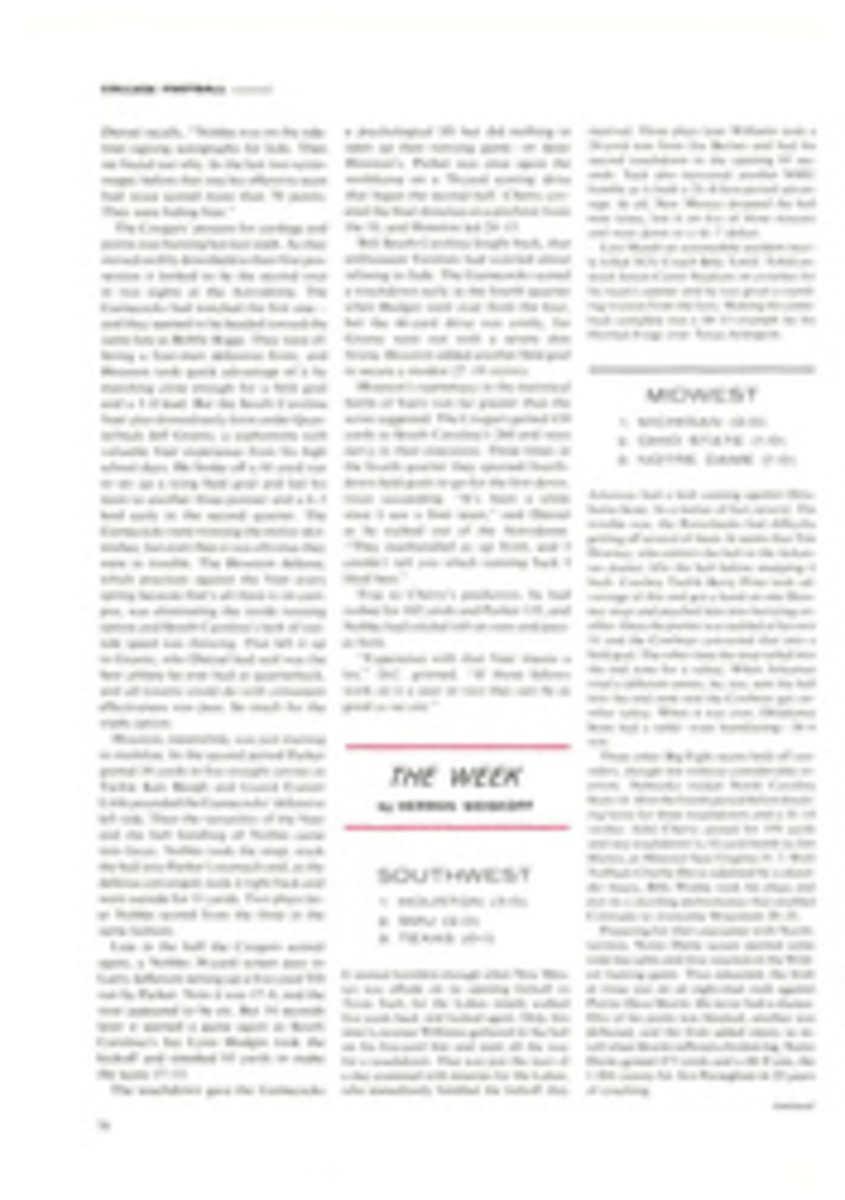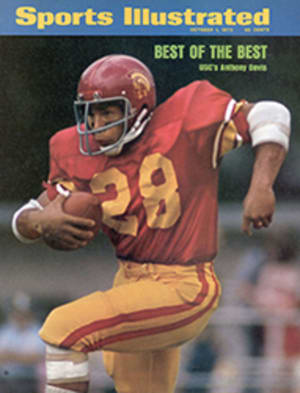
19TH HOLE: THE READERS TAKE OVER
NATURE OF THE GAME
Sirs:
Thank you for a solid pro football issue (Sept. 17). Good, progressive thinking is the stimulus the game needs to prevent stagnation of the kind that numerous writers and fans have attributed to baseball, and in his article No Boo-Boos Makes for Ho-Hums Tex Maule is attempting to provide just that.
In a prior issue Maule stated that a field goal is tantamount to awarding a team points for failing to move the ball. That is closer to the truth than any other written statement on the subject. There is nothing more disappointing than watching a team win by a field goal in a game's last 60 seconds, erasing 59 minutes of good football. Possibly the play should be done away with altogether. As for Maule's other proposals, they are excitingly interesting and deserve serious consideration from the team owners. The fans can only hope that the owners will follow up with positive action.
RONALD W. BERGERON
Cockeysville, Md.
Sirs:
Despite his predictable pick of Dallas as No. 1 in the NFC East, Tex Maule's pro football preview was interesting and incisive. It is unfortunate that the critics of the lifting of the TV blackout don't look at that issue from Maule's point of view. Granted there may be a revenue loss for the owners due to the new law. However, this may be precisely what is needed to get the reactionary NFL owners moving toward some of the changes Maule suggests. These changes would help ensure that people with tickets would not stay home.
JAMES WEIGERT
New York City
Sirs:
I enjoyed Tex Maule's article, but I disagree with his proposed changes to hype up the pro passing game. A zone defense (or a specialized defense such as the 53) makes it difficult to complete anything but short passes because it increases the necessity for accuracy. Nonetheless, a great quarterback on a good day and with adequate pass protection can defeat a zone or a specialized defense even if it includes 13 cornerbacks. Joe Namath, Bob Griese, John Hadl and others have demonstrated this. The answer, then, is in the development in college ranks of above-average passers and pass protectors. The college game at present, however, is geared toward the running game, and the Wishbone in particular. Even colleges that traditionally have produced exceptional passers, such as Alabama, Notre Dame and Purdue, are now emphasizing the running attack. The immediate effect will be to produce more running quarterbacks like Bobby Douglass.
To suggest that the colleges institute rule changes to increase passing is futile, since the NCAA considers itself to be anything but a minor league for the NFL. So the only genuine solution seems to be time. The colleges will, of necessity, develop defenses against the Wishbone and the ground game. The offense will, in turn, develop more and better passers to meet the challenge. The situation in the pros will then rectify itself. Any rule change in the pro game now may only create a monster. In the meantime, unfortunately, we must get used to four-yard passes on third and 30 from midfield.
MURRAY SLOVICK
Kew Gardens, N.Y.
Sirs:
Field goals may be boring, as Tex Maule says, but they are certainly more interesting than punts. And other things being equal, the longer the attempt, the more interesting the field goal. Maule's suggestions would totally eliminate the long field goal and replace it with the punt into the end zone, because teams would never risk giving up the ball near midfield. At the same time, starting every play midway between the sidelines will pressure coaches to go for the short field goal instead of the touchdown in the fourth-and-goal situations, because if the touchdown fails the coach no longer will have the post-game alibi of "the bad angle" precluding a sure three points.
I suggest a change in the roughing-the-passer rule to give the dropback passer the protection now enjoyed by the punter: if the defense does not get to the quarterback before he throws the ball, it cannot touch him unless it gets a piece of the ball in the air; if the quarterback rolls out or scrambles, he loses his special protection, and ordinary roughing rules apply. This would give the passer an extra second, enough to consistently beat any defense. It would also cut down on injuries to star attractions like Joe Namath, Bob Griese and Roger Staubach—the only other threat to pro football's continued prosperity.
RAY WILSON
Lincoln, Neb.
Sirs:
There may be a third remedy for "the cheap shot from the 50-yard line." Why not a three-point deduction for an unsuccessful field-goal attempt? The Serbian's leg would be prudently used, and the attempt could be as exciting as a goal-line stand.
HARVEY FIRARI
Culver, Ind.
COMIC RELIEF
Sirs:
For several months now I have been noting with increasing irritation your downgrading of an otherwise superb magazine with stupid, infantile cartoons. Each year I look forward to your college and pro football issues—annually your best and, in former days, including colorful photographs with the text. So what do I see on page 50 of the Sept. 17 issue? A huge, hideous "drawing" far more in keeping with Disgusting Comics than the top-rated sports magazine in America. Ugh! The entire article was almost ruined. But wait—with mounting nausea I found on ensuing pages not one or two but 12 more of these monstrosities. Unbelievable.
This acre of space could have been utilized a thousand times more effectively and artistically with an equal number of photographs of the pro stars.
NEIL H. SHREVE
Fairmont, W. Va.
Sirs:
The illustrations that accompanied your pro football reports were great. They depicted the game in a way that was funny and, considering some of the current attitudes in the sport, delightfully satirical. Thanks for a good laugh.
MICHAEL GREENE
Berwyn, Ill.
ROSY OUTLOOK
Sirs:
I want to congratulate William Leggett on a smashing article on Pete Rose (They Never Promised a Rose Garden, Sept. 17). I have been waiting all year for a good story about the Cincinnati Reds and now I have finally got it.
MIKE LEAL
Grafton, Ohio
Sirs:
I really enjoyed your article on Pete Rose. I have read his book and followed him for many years. He is the most dedicated man in baseball. If he keeps hustling and hitting at the same pace, the Reds surely will be in the World Series.
TONY TRUITT JR.
Savannah, Ga.
MEDICINE HAT TRICK
Sirs:
Now that hockey season is approaching, I'd like to draw your attention to a remarkable team. The Medicine Hat Tigers from Medicine Hat, Alberta are members of the Junior A Western Canada Hockey League. After only three short years in the league, they managed to make their way to the finals of the Memorial Cup, the championship of Tier 1 in junior hockey.
Such an achievement has never been recorded before. But there are more unusual things about the team. Tom Lysiak became the first player since Bobby Clarke to lead the league in scoring for two consecutive years. Boyd Anderson scored a record five goals in three minutes and seven seconds. For the first time in the West two of the top four NHL draft choices were from one team.
But I feel that the accomplishment of greatest human interest is that of the Gassoff brothers, Bob, Ken and Brad, who all played regularly with the Tigers. This is pretty unusual. Three brothers have never before played for a junior team at the same time. This year Bob will probably be playing with the St. Louis Blues, but a fourth brother, Gary, is in the Tigers' training camp, and many believe he will be the best of the lot.
I think your readers would be very interested in hearing about the Gassoff brothers. They are all scrappers, hard-nosed hockey players and, as you would find out upon interviewing them, sincere and dedicated young men.
NORMA BOZAK
Acadia Valley, Alberta
POOR PALOOKA
Sirs:
When SPORTS ILLUSTRATED saluted Joe Palooka on his birthday eight years ago (A Champ for All Time!!! April 19, 1965) I was thrilled to read that "the state of Indiana erected a 30-foot limestone statue of Joe on Highway 37 between Indianapolis and Bedford." After all these years of anticipation I finally saw that statue, and it was a sad let-down.
The statue, actually erected by the limestone industry, is closer to 10 feet than 30. It has been removed from the bluff overlooking the highway between Oolitic and Bedford and relocated in the small Fraternal Order of Police Park on the outskirts of Bedford.
Even worse than the neglect this once revered hero suffers is the fact that vandals have accomplished what none of his opponents in the ring ever could—they have broken his nose and knocked off parts of both ears. What a tragic comedown for the greatest sports hero of the funnies.
FENWICK ANDERSON
Champaign, Ill.
SPORTSMAN
Sirs:
Before all of the votes for Walter Alston, Jerry West, Jack Nicklaus, John Bench and George Allen come pouring in, I would like to nominate for Sportsman of the Year a refreshing and deserving athlete, 18-year-old Craig Virgin of Lebanon, Ill. Virgin's record as a runner borders on the unbelievable.
After vowing to top Steve Prefontaine's national high school two-mile mark of 8:41.6, Craig ran the distance in 8:41. He has appeared on our country's national junior teams for the last two years while only 16 and 17. As the 1972 and 1973 junior three-mile champion, he beat the Russian juniors in the 5,000-meter race this year. Craig also holds a variety of age and class track records.
Last Nov. 25 Virgin placed a highly impressive 13th out of 266 in the National AAU Cross Country Championships in Chicago. This feat is incredible for a high-schooler since most if not all of the other competitors were collegians, foreigners or club runners.
Craig Virgin is unsurpassed in the combination of dedication and quality. His dedication to the sport he loves is further exemplified by the fact that Lebanon High has no track. I urge SI to consider this athlete who has made it by himself without the help of sportswriters and media publicity.
TOM SHELL WORTH JR.
Atherton, Calif.
REVISED STANDINGS
Sirs:
Major league baseball needs a lesson in geography. Both St. Louis and Chicago are west of Cincinnati and Atlanta, respectively, yet the Cardinals and Cubs are in the East Division of the National League, while the Reds and Braves are in the West. If the National League were aligned according to geographical location, consider, for example, what the standings would have looked like as of Saturday morning, Aug. 25:
The Cardinals, leading in the East Division by 2½ games, would have been in fourth place in the West, 13½ games behind the front-running Dodgers. The Cubs, who were in third place, four games back in the East, would have been in fifth place in the West, trailing by 17½ games.
On the other hand, the Reds, doing well but trailing the Dodgers by four games, would have been in first place in the East, holding a whopping 12-game lead over the Pirates. The Braves, in fifth place in the West and 18 games down, would have been in third place, 14 games behind in the East.
The 1973 season is over now, but what about next year? When the San Diego Padres move to Washington, D.C., will they remain in the West Division? That would be about as ridiculous as it is to have the Vancouver Canucks of the National Hockey League, who are about as far west as you can get, in the East Division of the NHL.
WALT NEEDHAM
Allentown, Pa.
Address editorial mail to SPORTS ILLUSTRATED, TIME & LIFE Building, Rockefeller Center, New York, N.Y. 10020.

